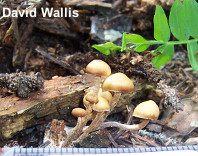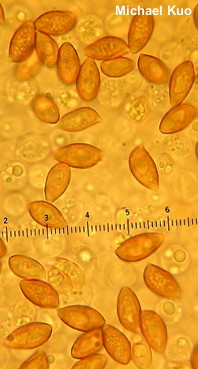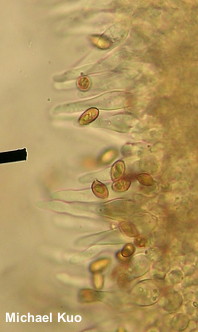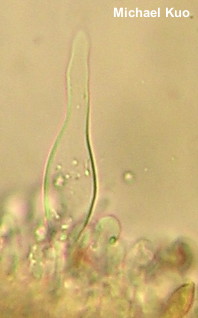| Major Groups > Gilled Mushrooms > Dark-Spored > Galerina badipes |

|
Galerina badipes [ Basidiomycota > Agaricales > Strophariaceae > Galerina . . . ] by Michael Kuo Like most species of Galerina, Galerina badipes requires a microscope for identification. Naked-eye features to look for include the fact that the cap is not (or only slightly) lined, and features a margin that is incurved and draped with tiny wisps of veil remnants when young. Microscopically, the species features two-spored basidia, narrow and nearly smooth spores, and hymenial cystidia that do not have swollen tips. Galerina badipes grows on well-rotted wood and on plant remains; its distribution in North America appears to be limited to western areas. The illustrated and described collection was made in a 2008 "mycoblitz" of Rocky Mountain National Park, sponsored by the National Park Service and the Colorado Mycological Society in order to document some of the fungi occurring within the boundaries of this national treasure. If you are active in a mushroom club or mycological society, I encourage your group to consider coordinating such a project with the officials at one of your area's state or national parks. The scientific usefulness of such projects is probably obvious, but consider the potential political implications of generating a scientifically sound list of fungal organisms found on public land. Description: Ecology: Saprobic on rotting wood and plant remains; growing alone, gregariously, or in clusters; summer and fall; western North America. The illustrated and described collection is from Colorado. Cap: 5–15 mm; convex at first, with an incurved margin; becoming broadly convex; sticky when fresh or wet, otherwise tacky to dry; bald; dull yellow, becoming yellowish brown; fading markedly as it dries out, creating a two-toned appearance; the margin adorned with whitish veil remnants when very young, becoming naked and faintly lined at maturity. Gills: Broadly to narrowly attached to the stem; close; short-gills frequent; off-white at first, becoming rusty brown as the spores mature; not bruising; at first covered by a whitish partial veil. Stem: 2–3.5 mm long; 2–3 mm thick; more or less equal; dry; flecked with whitish fibrils; sometimes featuring a thin, fragile ring zone; pale brownish above, turning darker brown from the base up; basal mycelium white. Flesh: Insubstantial; brownish; unchanging when sliced. Odor: Not distinctive. Spore Print: Rusty brown. Microscopic Features: Spores 10–12 x 5–6 µm; subamygdaliform; finely verruculose or practically smooth; reddish brown in KOH; dextrinoid. Basidia 2-sterigmate. Pleurocystidia and cheilocystidia similar; 40–75 x 5–13 µm; lageniform, with a long neck and a rounded, subacute, or subclavate apex; smooth; thin-walled; hyaline in KOH. Pileipellis a cutis or ixocutis. Clamp connections present. REFERENCES: (Persoon, 1801) Kühner, 1935. (Fries, 1838; Saccardo, 1887; Smith & Singer, 1964; Breitenbach & Kränzlin, 2000; Gulden, 2010.) Herb. DBG RMNP 2008-158. This website contains no information about the edibility or toxicity of mushrooms. |
© MushroomExpert.Com |
|
Cite this page as: Kuo, M. (2016, July). Galerina badipes. Retrieved from the MushroomExpert.Com Web site: http://www.mushroomexpert.com/galerina_badipes.html |



